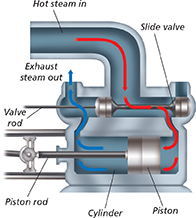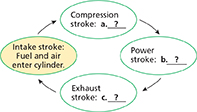16.3 Using Heat
Reading Focus
Key Concepts
 What are the two main types of heat engines?
What are the two main types of heat engines? How do most heating systems distribute thermal energy?
How do most heating systems distribute thermal energy? How does a heat pump reverse the normal flow of heat?
How does a heat pump reverse the normal flow of heat?
Vocabulary
external combustion engine
internal combustion engine
central heating system
heat pump
refrigerant
Reading Strategy
Sequencing Copy the cycle diagram below and complete it as you read to show the sequence of events in a gasoline engine.
Steam locomotives were one of the most important early uses of the steam engine. Prior to the locomotive, steam engines provided power for coal mines and mills. But don't think that steam engines are only a thing of the past. In fact, most electric power plants today use steam turbines, a very efficient kind of steam engine.
Heat Engines
Heat engines played a key role in the development of the modern industrial world.  The two main types of heat engines are the external combustion engine and the internal combustion engine.
The two main types of heat engines are the external combustion engine and the internal combustion engine.
External Combustion Engine
A steam engine is an external combustion engine—an engine that burns fuel outside the engine. Thomas Newcomen developed the first practical steam engine in 1712. His engine was used to pump water out of coal mines. In 1765, James Watt designed an engine that was more efficient, in part because it operated at a higher temperature.
Figure 11 shows one type of steam engine. Hot steam enters the cylinder on the right side. When the valve slides to the left, hot steam is trapped in the cylinder. The steam expands and cools as it pushes the piston to the left. Thus heat is converted into work. The piston moves back and forth as hot steam enters first on one side and then on the other side.

Figure 11 In an external combustion engine, combustion occurs outside of the engine.





